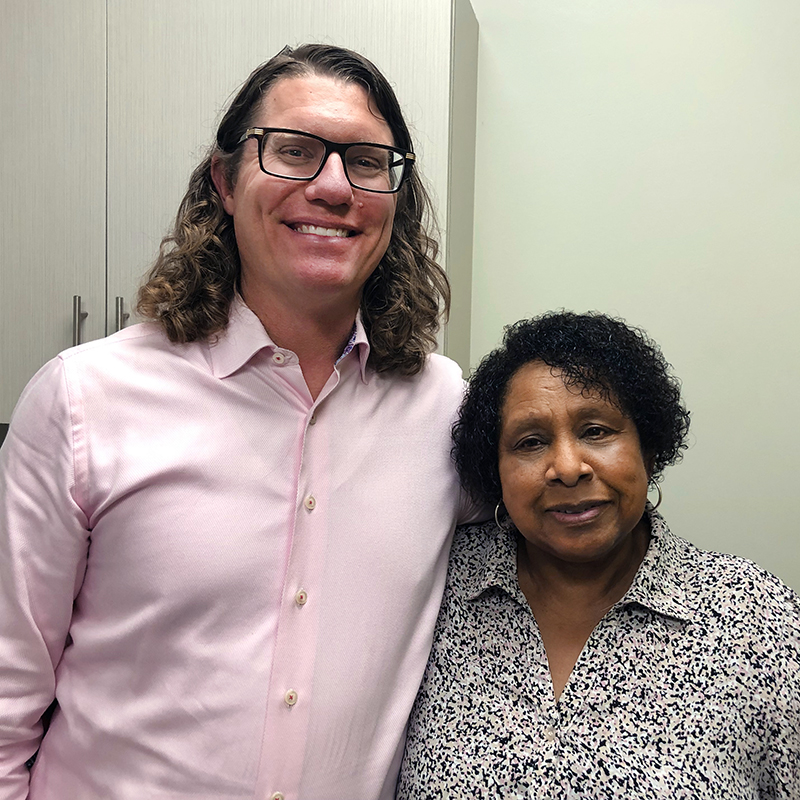
Charlotte's story
Spinal deformity
Trust in Dr. Kachmann helps fuel Charlotte's recovery
Charlotte showed up for one of her early visits with Dr. Michael Kachmann, and he told her simply: "I think I can help you."
And Charlotte trusted him.
"The more I talked to him, the more comfortable I felt," she says of the neurosurgeon at Mayfield Brain & Spine. "He's very thorough, and I liked him for being that way. When you have confidence in someone, you trust them. I knew that he would do what was best for me."
For Charlotte, that turned out to be a two-part surgery to straighten and rebuild the lower part of her spine. Her imaging showed spinal degeneration from the L2 level in the middle of her spine down to the S1 level near her pelvis. At all of those levels, she suffered from severe spinal stenosis, or a narrowing of the spinal canal that impinges on the nerves, as well as several types of spinal deformity.
Dr. Kachmann proceeded with the surgery in two phases. In the first surgery, he performed a lateral lumbar interbody fusion, or LLIF, to fuse the vertebrae from the L2 to L4 levels in Charlotte's spine. Then, working with Dr. Brian Kuhn, a vascular surgeon in the TriHealth system, he performed an anterior lateral interbody fusion, or ALIF, in the section just below, repairing the damage from the L5 to S1 levels. Surgeons go through the abdomen in this surgery to access the front of the spine where the disc is located. In the second phase, Dr. Kachmann worked with his Mayfield colleague, neurosurgeon Dr. Zachary Tempel, to reconstruct and stabilize the entire lower portion of Charlotte's spine, from the L2 level all the way down to the pelvis.

Dr. Kachmann said Charlotte's stenosis and other disorders spanned multiple levels of her spine and restricted the nerves in several spots, leading to the conclusion that a complex operation to reconstruct that entire section of the spine would help her the most. He is part of Mayfield's spinal deformity team, which has developed expertise in mitigating the impact of scoliosis, a sideways curve of the spine, and other serious disorders.
"Surgery to correct a spinal deformity can have amazing benefits for patients who are seeing degeneration at multiple levels of the spine and significant impairment in the way they can walk, sleep or work," Dr. Kachmann said. "In Charlotte's case, we were able to isolate specific issues that were affecting her nerves and discs, then stabilize the spine so she could heal and begin to regain strength and function."
After years of back pain that had radiated down her legs and limited her ability to walk or even stand straight up, Charlotte is working hard on her own recovery and feeling better. She spent nine days in the hospital and 14 days in inpatient rehab, and continues to work with Mayfield Physical Therapy to increase her strength and range of motion. But she is off the painkillers and doesn't even take Tylenol anymore.
"I knew the majority of the work was done, and it was up to me to listen to Dr. Kachmann and do what he wanted me to do," she says.
Her back trouble started more than a decade ago, and she has gone through a series of pain injections, physical therapy sessions and other treatments. When the pain down to her knee got so bad that she couldn't walk, she found herself gaining weight, which only increased her frustration. She says the condition of her back "just kind of spiraled out of control."
A friend recommended that she consult with Dr. Kachmann, who has practiced at Mayfield since 2014 and is a leading expert on the team that finds solutions for patients with scoliosis or spinal deformity.
"At first, I was kind of leery," Charlotte says. "But I had done my homework. If you don't do your homework, you'll never find out how good somebody is. The more I talked to him, the most comfortable I felt."
~ Cliff Peale
Hope Story Disclaimer -"Charlotte's Story" is about one patient's health-care experience. Please bear in mind that because every patient is unique, individual patients may respond to treatment in different ways. Results are influenced by many factors and may vary from patient to patient.

